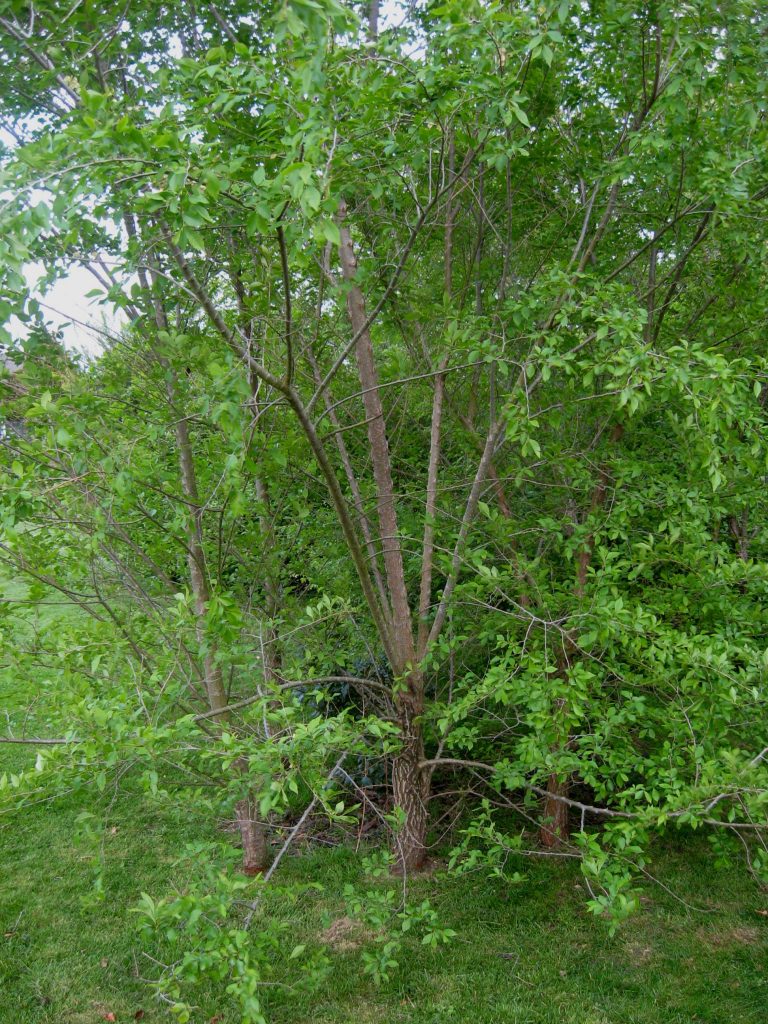Elms have long been valued as landscape, hedgerow and woodland trees. They are also environmentally tolerant, beautiful and valuable timber trees, which host 80 species of invertebrates.
About elm
In Great Britain, the only truly native species is the Wych elm (Ulmusglabra) which has a more northerly and westerly distribution. The Field elm (U.minor), found inmainly in central and southern England, was introduced in prehistoric times by man (Richens, 1983). The latter includes clones such as English elm (U. minor ‘Atinia’, previously known as U. procera and typically sterile) and Plot Elm (U. minor ‘Plotii’). Both Wych elm and Field elm can hybridise easily and naturally occurring hybrids are frequent. Oliver Rackham (1980) described Ulmus as the most difficult critical genus in the entire British flora, adding that ‘species and varieties are a distinction in the human mind rather than a measured degree of genetic variation’. During the 19th and early 20th centuries many cultivars and some exotic species were also planted as ornamental street, garden, and park trees.
Over the past century there have been two pandemics of Dutch Elm Disease (DED) caused by two entirely separate but related species of microfungi, Ophiostoma ulmi and O. novo-ulmi (Brasier, 1991, 2000). Together, these pathogens have killed many millions of elm trees resulting in the decimation of the British elm populations. Over 90% of the British elms died during the late 1960s and 1970s, estimated at over 25 million trees (Brasier 2000; Brasier & Webber 2019; Coleman, 1998). This massive impact on the countryside and society is still clearly recalled today. It can be most evidentially seen by the loss of the mature elm trees in woodland and hedgerows and their subsequent replacement by root suckers which grow up for 5 to 20 years before succumbing to disease again (Brasier & Webber, 2019).
But not all has been lost. Since the 1990s, it has been apparent that isolated, small populations and individual trees have survived and maybe avoiding, tolerant or resistant to DED. With other native species such as ash and oak under increasing pest and disease pressures, there is currently much interest in re-considering elm with an objective of conserving, improving and ultimately restoring elm back into the landscape at a meaningful level.

Small populations of elm trees still survive in the UK.
Our work on elm
It has become apparent that key elm resources are held by various individuals and by different organisations. To secure and safeguard these resources for future reference, research and development, it is critical that these are properly documented to establish a national elm resource. In the case of plant material, important rare individuals should be replicated and planted on secondary secure sites.
a) Review, consolidate existing key data and plant material, and archive when appropriate
Datasets to be compiled can be broadly split into:
1) Information on mature elms trees in situ and contact persons
2) Collections and trials of species, varieties, selections propagated from mature DED tolerant treesplus seedlings including formal and informal sites. In reviewing the plant material held in collections and trials, material at risk of being lost, i.e. only present at one site, if considered of interest should be prioritised for propagation and planting at a second site.
b) Identify, conserve, characterise and test mature elms for DED tolerance
In addition to point ‘a’ above, there is existing additional knowledge in the wider ‘tree’ sectors, interested landowning and general public which needs harnessing to complement and extend the collection of British mature trees for further study. A collection of mature trees with timber potential should be created to form the basis of a future seed orchard.
c) Assess adaptiveness of elms including hybrids
The network of existing adaptive trial sites provides highly valuable information on the performance and suitability of elm varieties including hybrids and species to different soils and climates, and their ability to support biodiversity, notably the White-letter Hair Streak butterfly. It is essential that these trials are maintained and monitored. It is also essential that new, replicated trials are established which include new material and reference material.
d) Develop British elm varieties, particularly those with DED tolerance
Via the backcrossing of hybrid elm with outstanding mature examples of British elm, novel DED tolerant offspring have been identified. These need to be propagated and trialled to assess performance included DED tolerance under different site conditions. In addition, further progenies should be generated to increase the diversity of British elms varieties. The use of elm species such as European white elm (Ulmus laevis) which avoid DED should be considered as potential breeding with British as well as species which have resistance.
e) Promote the use of elm for planting and timber
Strategies to adopt the planting of elm which cater for different planting objectives needto be developed and promoted. The ‘buy in’ of the conservation bodies and administrative bodies as well as the amenity and forestry sector needs to be secured. Support of the nursery sector to invest in elm should be a priority. A key priority for support is to facilitate the acquisition of Plant Breeders Rights for the propagation of existing resistant clones that have proven to be adapted to UK growing conditions. This links to and enablesthe planting of resistance elms arising from items c & d. There is a substantial resource of small to medium dimension elm timber being under-utilised in Britain which is suitable for structural and decorative uses. This is in part because of the lack of awareness of potential markets and uses. Utilising such timber would not only help meet the sustainability and climate change agendas but also would reduce the availability of declining elm as a breeding resource for the elm bark beetles. Thus investment is required to promote and develop the elm timber chain.
f) Engage with the scientific community to develop and applyscientific ‘tools’ which would advance knowledge, provide robust data and increase confidence in the planting and use of elm
There is work required to build elm partnerships involving private, industry and research parties on a national and European level. This would promote the exchange of knowledge and aid the development of research projects and best practice.
